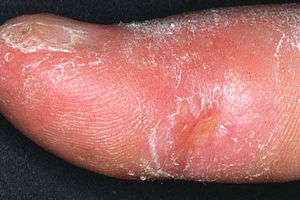Piecemeal necrosis

Sclerotic piecemeal necrosis of the tip of the thumb in a patient with scleroderma.
Piecemeal necrosis generally refers to a necrosis that occurs in fragments.
Liver
When used in relation to the liver, piecemeal necrosis (also termed troxis necrosis,[1] nibbling necrosis[1] and interface necrosis[1]) refers specifically to a loss and degeneration of (limiting plate) hepatocytes at the lobular-portal-interface, producing a moth-eaten irregular appearance.[2] Piecemeal necrosis of the liver is associated with a lymphocytic infiltrate[2] into the adjacent parenchyma,[3] and with destruction of individual hepatocytes along the edges of the portal tract.[3]
It is a feature of viral hepatitis (especially chronic hepatitis) as well as autoimmune hepatitis and steatohepatitis.[1]
References
- 1 2 3 4 Wang, M.; Morgan, T.; Lungo, W.; Wang, L.; Sze, G. Z.; French, S. W. (2001). ""Piecemeal" Necrosis: Renamed Troxis Necrosis". Experimental and Molecular Pathology. 71 (2): 137–146. doi:10.1006/exmp.2001.2397. PMID 11599920.
- 1 2 Pathbase > MPATH 597: cell and tissue damage process > MPATH 13: piecemeal necrosis Retrieved July 2, 2011
- 1 2 Transplant Pathology at the University of Pittsburgh > Chronic hepatitis > Chapter 3 > PATHOLOGIC FEATURES Last Modified: Mar 12, 2010
This article is issued from Wikipedia - version of the 8/16/2015. The text is available under the Creative Commons Attribution/Share Alike but additional terms may apply for the media files.